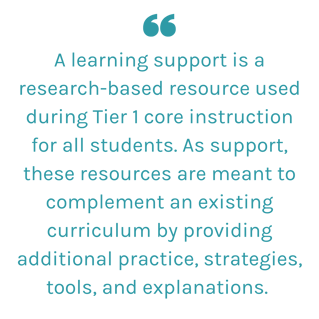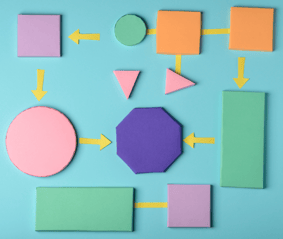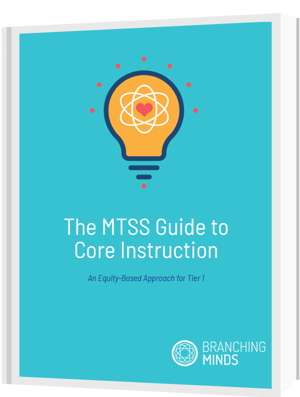The three-tiered support structure of a Multi-Tiered System of Supports (MTSS) provides efficient and effective support for all students. This support begins at the core level, also known as Tier 1. At Tier 1, all students receive differentiated instruction that is scaffolded with research-based learning supports, tailored to meet the needs of all students.
Tier 1 is provided for all students all the time. But as anyone in the classroom can vouch, all students have different learning needs. To address these needs and create a strong foundation of learning, differentiation and intervention begin at the core level. This is where learning supports are used to provide that differentiation and scaffolding.
Confused? Don’t be. We’re here to help. Below, we have taken a moment to define what learning support is, discuss how it’s used, and provide a few examples to add clarity.
What Are Learning Supports?
A learning support is a research-based resource used during Tier 1 core instruction for all students. As support, these resources are meant to complement an existing curriculum by providing additional practice, strategies, tools, and explanations.
These supports are especially useful during accelerated learning, where all students may be missing a critical learning component, and additional supports are needed to help students master grade-level content. They can be ongoing throughout the year and are often reused to assist in different points of the curriculum.
 Learning supports are used for all grade levels. If you’re looking for specific guidance for your school level, check out our resource for Tier 1 at the Secondary Level and Tier 1 at the Elementary Level.
Learning supports are used for all grade levels. If you’re looking for specific guidance for your school level, check out our resource for Tier 1 at the Secondary Level and Tier 1 at the Elementary Level.
But what about interventions and accommodations? Many of the tools, strategies, and programs we use to support our students as research-based interventions can also double as learning support at our Tier 1 level. The key is how this resource is applied and the level of need required for a student.
How To Use Learning Supports at the Tier 1 Level
The biggest takeaway when selecting appropriate learning supports to utilize is selecting targeted, research-based, and aligned with core instruction. The focus and purpose of learning supports are to provide support for a data-identified skill gap.
Universal screeners and benchmarks can provide educators with an overview and understanding of the needs of their students. Using this data, we can begin to identify areas of the curriculum that will require additional support for students to reach grade-level mastery.
These areas and skills are where learning supports are incorporated to provide that additional support and leverage to help students master concepts and show mastery. Learning supports can also be used to increase engagement because we’re all tired of resorting to theatrics to get our students to pay attention.
It’s important to remember that learning support does not replace a robust and strong core curriculum. So, it’s crucial to have a clear understanding of power standards, key concepts of grade-level content, and data on current student needs before selecting learning support. Once all those ducks are in a row, go forth and prosper.
Examples of Research-Based Learning Supports for Tier 1 Instruction
I’m going to start by clarifying–this list is not exhaustive. This is merely a guideline and example of learning support that can be utilized to provide support for all learners at the core level.
The Branching Minds resource library contains hundreds of research-based learning supports to aid our educators in their core instruction. These are evaluated and categorized based on their research/evidence alignment with ESSA. However, educators can also use resources such as Intervention Central, What Works Clearinghouse, and Reading Rockets to identify research-based learning strategies, tools, and resources to support their Tier 1 instruction. That just takes a bit more leg work.
In the examples below, we’ve focused on three areas: Social-Emotional Learning, Reading, and Math. However, many evidence-based learning strategies can be utilized cross-curricular (Don’t worry other subjects, we love you, too). To be fair, SEL is embedded into all subjects, so these strategies and resources are not limited to their categories.
Learning Support for Social-Emotional Learning
PBIS (Positive Behavior Incentive Program)
Taking time to find research-based learning support specifically targeting behavior and SEL needs can help address many of the challenges that arise at the Tier 1 level. A PBIS program is a school-wide preventative framework focused on developing positive and prosocial behaviors.
Instead of focusing our energy only on punishing negative behaviors, PBIS emphasizes and focuses on rewarding positive behaviors. It’s like what my mom used to always tell me, “You catch more flies with honey than with vinegar.” I’ve now come to the realization that my mother was indeed always right.
PBIS has been proven to decrease negative behavior occurrences at the school and class levels. It has also been shown to increase a positive school culture, leading to more respect and open communication between students and staff as a Tier 1 learning support. PBIS creates a positive and cohesive learning environment for all students and supports academic success.
Learning Support for Reading
Graphic organizers are a common sight in many English and Reading classrooms. However, this free, research-based learning support can also be used in other subject areas as a tool to organize and synthesize information to increase comprehension. 
Organizers help students break down complex texts and material into manageable chunks and construct meaning from what they have read. Teachers can use graphic organizers at the Tier 1 level to scaffold more difficult concepts and texts to increase student comprehension.
Beyond increasing reading comprehension, graphic organizers can also improve writing skills. Teachers can model graphic organizers during a lesson, and then allow all students time to practice on their own or in small groups.
Learning Support for Math
Math Manipulatives
In 2020, math manipulatives made the list as one of the most commonly used Math supports on the Branching Minds platform. This is not surprising given how effective and relevant math manipulatives can be as learning support across subject and grade levels.

Math manipulatives help students visualize and develop a deeper understanding of math concepts, ranging from basic counting to more complex skills such as multiplication and division.
When used as a support for an appropriate concept or skill, manipulatives have been proven to lead to higher retention, problem-solving, and justification skills as opposed to using abstract symbols. Teachers can model the use of manipulatives throughout a lesson and problem-solving activity, then allow students the opportunity to practice on their own.
Similar to graphic organizers, manipulatives can be used at all tier levels. However, by incorporating them into Tier 1 instruction, educators can provide a strong foundation of math fluency for all students.
Final Thoughts
By incorporating learning supports into Tier 1 instruction, educators can provide the differentiation and scaffolding needed to address the wide variety of needs and skill levels evident in every classroom. It’s important to remember that learning supports should be identified and utilized in conjunction with assessment data and a strong, core curriculum.
While we have provided a starting point, don’t limit your investigation to Tier 1 supports with what you see here. Branching Minds offers a variety of great resources, blogs, and webinars that dive deeper into the many components of Tier 1 instruction, MTSS, and intervention.
Check out our resource page for some great content and learning, and be sure to follow Branching Minds on your platform of choice if you just can’t get enough of MTSS—I promise we share some fun stuff and interesting tidbits of knowledge.
Download the MTSS Core Instruction Guide

Interested in Learning About Our Library of Curated RTI/MTSS Evidence-Based Interventions?Branching Minds has the most comprehensive and instructive library of evidence-based learning supports of any MTSS platform. Our supports include hundreds of paid evidence-based intervention programs, as well as nearly a thousand free evidence-based strategies, activities, and resources. For each of these supports, BRM helps educators understand what the support is, why and for whom it should be used, how it should be delivered, and connects them to the supporting research and additional material. Our learning science team has curated these resources from the most trusted and respected hubs of evidence-based supports, including the Florida Center for Reading Research, What Works Clearinghouse, Evidence for ESSA, Intervention Central, the IRIS Center from Vanderbilt University, Harmony SEL; and, each one has been reviewed and categorized based on the ESSA tiers of evidence guidelines. |
![[Guest Author] Mollie Breese-avatar](https://www.branchingminds.com/hs-fs/hubfs/Team/Mollie%20Breese%20Headshot-1-1-2-1.jpeg?width=82&height=82&name=Mollie%20Breese%20Headshot-1-1-2-1.jpeg)
About the author
[Guest Author] Mollie Breese
Mollie Breese is the former Content Manager at Branching Minds. She helped streamline the support library, so schools can identify and access the interventions they need to support student success. She researched the newest strategies, activities, and programs to add to the robust library, providing a wealth of resources for partner schools. Prior to joining Branching Minds, Mollie worked in the classroom as an English teacher, Reading teacher, and ESL instructor. Mollie earned her B.A. in Political Science from the University of Missouri, and her M.A. in English Literature from the University of Glasgow.

Your MTSS Transformation Starts Here
Enhance your MTSS process. Book a Branching Minds demo today.
















.png?width=716&height=522&name=Addressing%20Foundational%20Reading%20Skills%20in%20MTSS%20(preview).png)
.png?width=716&height=522&name=Understanding%20Literacy%20Basics%20(Preview).png)
.png?width=716&height=522&name=Behavior%20Progress%20Monitoring%20(Preview).png)